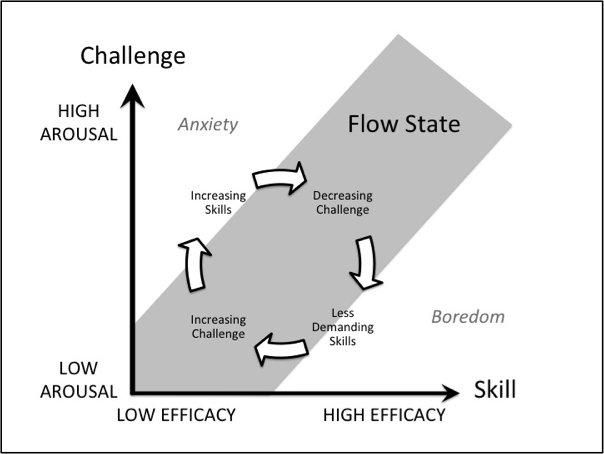
Whitewater kayakers and musicians experience it. So do video gamers, rock climbers, and experienced meditators. If you’ve ever experienced losing complete track of time or your sense of self when you are engrossed in a difficult yet satisfying task, chances are you have experienced it too. They call the optimal state of consciousness in which you perform and feel your best ‘flow’.
What is flow?
The concept of flow was first described by positive psychologist Mihály Csíkszentmihályi who described it as:
“a state in which people are so involved in an activity that nothing else seems to matter; the experience is so enjoyable that people will continue to do it even at great cost, for the sheer sake of doing it.”
When you’re in state of flow you:
- intensely and completely focus on the present moment and the task at hand
- forget about yourself, others, and the world around you
- feel a complete sense of control or mastery over the situation or activity
- loose all sense of time
- complete the task because the task itself is intrinsically rewarding.
Csíkszentmihályi’s work in the area started after he became curious about what motivated people, and what activities induced greatest enjoyment or deepest satisfaction. He interviewed thousands of people including Dominican monks, blind nuns, Himalayan climbers, and Navajo shepherds, all who enjoyed their work, and one similarity emerged,
“…what kept them motivated was the quality of the experience they felt when they were involved in the activity…it often involved painful, risky, difficult activities that stretched the person’s capacity and involved an element of novelty and discovery,”
Here’s a link to Mihaly Csikszentmihalyi’s TEDx talk on why flow is the secret to happiness, where he asks, “What makes a life worth living?” Noting that money cannot make us happy, he looks to those who find pleasure and lasting satisfaction in activities that bring about a ” flow state.”
How can we trigger flow?
One of the most important triggers for flow is the very specific relationship between the difficulty of the task and your ability to perform that task. If the challenge is too great, then fear or frustration take over. If the challenge is too easy, you stop paying attention. Flow appears in a ‘sweet spot’ — the midpoint between boredom and anxiety.
Flow, Csíkszentmihályi, says is experienced as intrinsically rewarding such that participants undertake a flow-inducing task “for its own sake, with little concern for what they will get out of it, even when it is difficult.”

Steve Kotler, ‘flow hacker’ and author of ‘The Rise of Superman. Decoding the science of ultimate human performance’ has identified numerous triggers for flow. Broadly they all drive attention to the ‘now moment’. Kotler believes flow involves:
- Focus. Fear or immediate threats focus the brain, so a high-stakes or high-consequence environment can trigger flow.
- Risk. ‘Danger’ can feel good, but only if the risk can be moved from one of threat to one of challenge.
- Challenge vs Skill. Find the sweet spot between boredom and fear. Kotler estimates the challenge should be ~4% greater than your skill level.
- Novelty. Change, unpredictability and complexity catch and hold your attention.
- Embodiment. It involves being ‘in’ your body and fostering full body awareness. Adventure sports often require a kind of total physical awareness and immersion in all five senses.
- Clear goals. What is your purpose? Clear goal setting allows the setting of micro goals, which close the feedback loop sooner, giving access to immediate feedback.
- Feedback. This term refers to a direct, in-the-moment coupling between cause and effect. Immediate feedback is an extension of clear goals. Clear goals tell us what we’re doing; immediate feedback tells us how to do it better.
What is the biological basis for flow?
Several studies performed with professional classical pianists who played piano pieces several times to induce a flow state found a significant relationship between flow and decreased heart rate, blood pressure, and relaxation of the zygomaticus major facial (smiling) muscles.
Years ago Csíkszentmihályi suggested that the prefrontal cortex (PFC aka, the brain’s CEO) might ‘switch off’ during flow. However, brain-imaging studies of entering the flow state by playing the computer game Tetris didn’t confirm Csíkszentmihályi’s hypothesis. Instead, they found the opposite: flow arises through an interaction between positive emotions and high attention or focus; that is, when the PFC is highly activated. Flow states often involve the cognitive skills of attention, planning, goal maintenance, performance monitoring, response inhibition, and reward processing — all functions of the PFC.
Why go with the flow?
Losing yourself in flow activities has the capacity to improve your happiness, and the concept has become embedded in positive psychology practice. But if you need more inspiration to find that activity that engages and enthrals you, Steve Kotler believes,
“Flow is the very thing that makes us come alive. It is the mystery. It is the point.”
2023 Research Updates:
🌱 Brain stimulation is one useful, albeit sci-fi, way to induce flow states. Scientists have shown that flow states can be induced using a type of non-invasive brain stimulation called transcranial direct current stimulation (tDCS) targetted to the PFC. Interestingly, tDCS is most effective at inducing flow in people who don’t usually experience it. Furthermore, if a flow state is induced with brain stimulation when playing TETRIS, it causes increased performance, specifically in people who are less-experienced TETRIS players.
🌱 Another defining flow characteristic is the strong attentional focus and low levels of self-referential thinking (daydreaming or thoughts, images, and feelings about yourself and your life). Self-referential thinking and daydreaming are linked to the brain’s default mode network (DMN), while the deployment of attention is linked to the PFC. fMRI scans of brain connectivity in people playing video games showed ‘losing’ the flow state because the game was too easy or hard, causing the DMN to become activated.
🌱 Flow research has continually implicated the PFC. However, a 2022 review paper including 25 flow studies and 471 participants highlighted the extreme variability in PFC activation across studies. Some researchers have instead proposed that the dopamine reward system and the locus coeruleus-norepinephrine system are largely responsible for the induction of flow states. Ultimately, more well-designed studies are needed to draw more reliable conclusions on the neurobiological basis of flow.
Watch this space!
Share the love
[Sassy_Social_Share]
5 Comments
Leave a Comment
About Dr Sarah
Neuroscientist, Author, Speaker, Director of The Neuroscience Academy suite of professional training programs.
Latest Posts
Free 10 day micro-training in neuroscience

Learn one neuroscience concept a day!
10 simple, bite-sized lessons in brain health, delivered daily to your inbox


Excellent explanation (even clearer than Csíkszentmihályi’s book on FLOW) and love the quotes. Would be interested in anything you have to say about FLOW and making money – obviously people do make money whilst in a FLOW state but getting to that point ion one’s career seems more than a little challenging at times!
Brilliant. I’ve been talking about flow states with my coaching clients for over a year now and I love Kotler’s quote.. It is the point. I couldn’t agree more. Thanks for the great post!
I love this article. I wrote an essay on wellbeing for my MSc and included flow linking it to how running helps my own mental health. So reading this is part revision and part update. I wish it had been around before I wrote my (academically referenced) essay.
Thank you.
Would reaching a state of bliss during meditation be considered a flow state? In other words, while doing nothing? The PFC is off. Is the brain chemistry similar to the rock climber on the ledge?